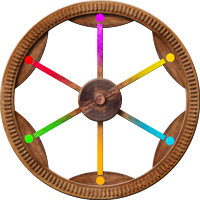The Background of Western Tantra
The word tantra has several meanings, one of which is that of "scriptures", words of wisdom that have been taught orally by a teacher, and then written down, words of experience rather than words of a theory or philosophy. Many texts go back as much as 4000 years, and the wisdom itself is thought to come from pre-vedic, tribal times. The body of knowledge is arrestingly similar to that taught as fire medicine in the native American tradition, and there is good reason to believe that it is the remains of an ancient culture from times when people lived close to the earth, the goddess was honoured, and the relationship between men and women was not an expression of property but a celebration of the the mystery of life, seen in the macrocosm as the embrace of the sun and the earth, and in the microcosm as the miracle of perception embodied in the dance of Shiva and Shakti as consciousness and energy, sperm and egg meeting to create new life.
With the advent of the major religions tantra went underground, and became an esoteric tradition that still exists in quiet places, but maligned and distorted by the public imagination - in the West as sex orgies, in India as black magic. This successfully frightens many people away from experiencing its life enhancing and consciousness expanding teachings.
Tantra divides into two major traditions: the right-handed path and the left-handed path. Both see the universe arising out of the ecstatic dance and sexual union of the feminine and masculine principles, energy and consciousness, represented in the forms of god and goddess.
The right-handed path works with the sexual energy through sublimation, visualization and meditation as worship of these principles.
The left-handed path challenges the follower to embody these energies, to become the god or the goddess and manifest energy and consciousness in themselves, in their thoughts and actions, in their awareness.
John Hawken's The Tantric Path follows this left-handed tradition.
The left handed path is practised not only by professionals, priests or monks withdrawn from life, but by ordinary women and men living in the middle of life, in the market place. Relationships, and especially one's primary sexual relationship, can therefore become the conscious spritual path of growth.
Instead of repressing desire and sexuality and pleasure as a distraction from the spiritual path of transcendence, the student gives the self into it completely, letting it become the tattva, the gateway, through which to lose the ego in the surrender to that which is greater than the self. Desire followed with totality and abandon takes one beyond, beyond the duality of attachment or nonattachment, guilty or not guilty, sexual or spiritual, into being innocently in bliss.
In the 1970s the Indian mystic Osho, previously known as Rajneesh or Baghwan, created a blend of tantra and humanistic psychotherapy that became tantra for the West. This was brought to Europe by Margot Anand as SkyDancing Tantra, by Michael Plesse and Gabriele St Clair of Orgoville International to Germany, and in a later wave by Sarita in France/UK and Astiko in Spain as Osho neo-tantra. Daniel Odier teaches Kashmiri Shivaite tantra in Paris. Margot trained teachers in 1991-2 and set up SkyDancing Institutes in the USA, Germany, Switzerland, the Netherlands, and France, including that in the UK directed by John Hawken.
Some traditionally-minded tantric students and practitioners fear that the practice of left-handed tantra without long preparation and real dedication can debase the legacy of tantra and entangle workshop participants deeper in their own egos. There are indeed many tantra teachers who offer, and participants happy to consume, tantra as a new age entertainment and social activity. The attempt to simultaneously bring together sexuality and spirituality is a high endeavour. Yet if a serious student finds an experienced and inspiring teacher she or he can live moments of transcendence and empowerment, and create lasting personal transformation. And the path, the journey itself, is full of insights, moments of joy, and positive change.
John Hawken






